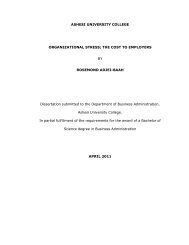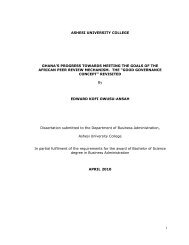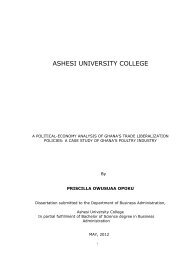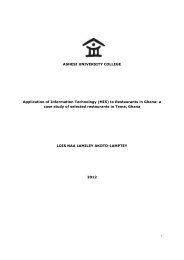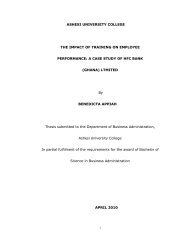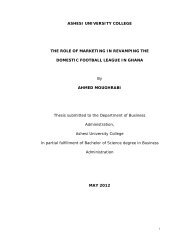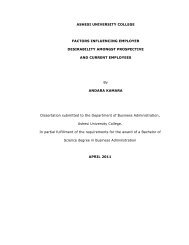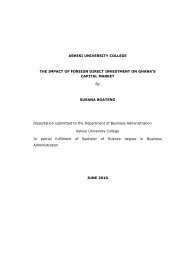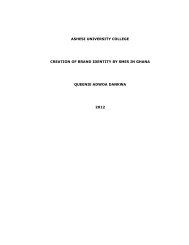ASHESI UNIVERSITY COLLEGE - Ashesi Institutional Repository ...
ASHESI UNIVERSITY COLLEGE - Ashesi Institutional Repository ...
ASHESI UNIVERSITY COLLEGE - Ashesi Institutional Repository ...
Create successful ePaper yourself
Turn your PDF publications into a flip-book with our unique Google optimized e-Paper software.
embedded deeply in the everyday life of individuals and are typicallyimpervious to change (Newman &Nollen, 1996).Cultural transmission is primarily achieved through the process ofsocialisation. Within organisations, socialisation can therefore be defined asthe process by which individuals fit in or become adjusted to new roles andlearn the content of information necessary for adjustment to this new role(Stahl &Caligiuri, 2005 as cited by Payne, 2011). This can also be referred toas training. “Socialisation is therefore essentially a learning process and hasbeen described as an expatriate coping strategy” (Payne, 2011, pg.1). It isthrough this socialisation or training that individuals are taught the sociallyacceptedmanner in which various forms of communication may be carriedout within a specific culture. This is what creates the distinct national cultureof people. Drawing on the works of Hofstede, every nation has a uniquelydistinct culture. When socialisation is carried out in children and they growand also pass this training onto future generations, it becomes fused into thebehaviours and norms of the people in the country. We are all subject to this,based on our upbringing and the environment that we were exposed to.This study realizes the effects of socialization and training on theeffects of culture. In order for differences that are so deeply rooted in thebehaviour and belief systems of individuals to be addressed and worked on,some form of identification and training must be done.There is the belief that various cultures of the world are increasinglyconverging, and this will increase the similarity that exists amongstinternational business practices of various cultures and reduce the occurrenceof any complexities (Leung et al, 2005). This would imply that cultures of12




